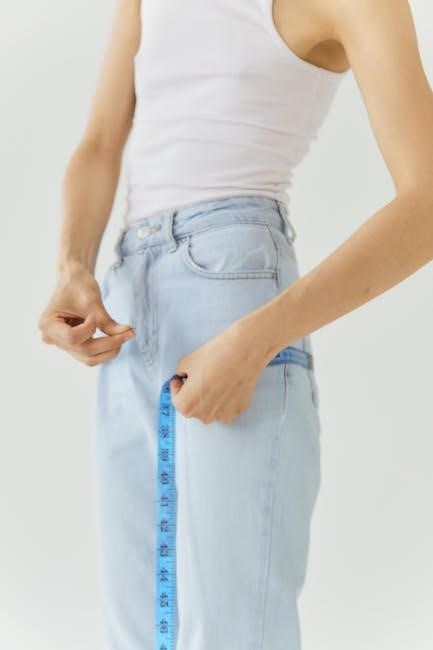A table runner size guide helps you choose the perfect fit for your table‚ ensuring a balanced and stylish appearance. Proper sizing enhances decor and functionality‚ providing a polished look for any occasion.
Understanding the Importance of Proper Table Runner Sizing
Proper table runner sizing is essential for achieving a balanced and stylish appearance. A runner that is too narrow or too wide can disrupt the aesthetic harmony of your dining space. It not only enhances the visual appeal but also serves functional purposes‚ such as protecting the table from spills or scratches. Incorrect sizing can make the runner look out of place or overwhelm the table‚ defeating its decorative purpose. Additionally‚ proper sizing ensures the runner drapes elegantly‚ creating a polished look. By understanding the right dimensions‚ you can select a runner that complements your table’s shape and size‚ ensuring both functionality and beauty. This guide helps you make informed decisions for a flawless setup.
Overview of Table Runner Dimensions
Table runners come in various lengths and widths to suit different table sizes and shapes. Standard dimensions typically range from 12 to 20 inches in width and 30 to 90 inches or more in length. The ideal runner should complement the table’s proportions‚ with a recommended overhang of 6 to 12 inches on each end for a polished look. For example‚ a 42-inch wide table might use a 14-inch wide runner‚ while larger tables may require wider options. These dimensions ensure the runner enhances the table’s appearance without overwhelming it‚ making it suitable for both decorative and functional purposes.

Measuring Your Table for the Perfect Fit
Accurate measurements are essential for selecting the right table runner. Use a measuring tape to determine your table’s precise length and width for the best fit.
How to Measure Your Dining Table’s Length and Width
To measure your dining table accurately‚ start by identifying the length and width. Place a measuring tape along the longest edge for the length and the shortest edge for the width. For a standard rectangular table‚ measure the length from one end to the other and the width across the shorter side. Ensure the tape is straight and flat for precise measurements. Note these dimensions to determine the ideal table runner size‚ allowing for an overhang of 6 to 10 inches on both sides for a polished appearance. Record both measurements to guide your table runner selection process.
Calculating the Ideal Table Runner Length
To calculate the ideal table runner length‚ consider the table’s length and desired overhang. A standard overhang ranges from 6 to 12 inches on each end‚ adding elegance without overwhelming the setup. For a 72-inch table‚ add 12 inches to the total length‚ resulting in a runner length of 84 inches. If you prefer minimal overhang‚ reduce the additional length accordingly. This ensures the runner complements the table’s dimensions while maintaining a balanced look. Proper calculation guarantees a seamless fit‚ enhancing both functionality and aesthetics for any dining or decorative setting.
Determining the Appropriate Table Runner Width
The width of a table runner should complement your table’s dimensions without overwhelming it. A general rule is to choose a runner width that is approximately one-third of the table’s width. For example‚ a 48-inch-wide table pairs well with a 16-inch-wide runner. Standard widths typically range from 12 to 18 inches‚ but larger tables may require up to 20 inches for a proportional fit. Measure your table’s width and divide by three to find the ideal runner width. This ensures the runner adds a decorative touch without obscuring the table’s surface or interfering with place settings. Proper width selection balances functionality and aesthetics.

Standard Table Runner Sizes
Standard table runner widths typically range from 12 to 18 inches‚ while lengths vary from 30 to 90 inches‚ depending on the table’s size and desired overhang.
Common Widths for Table Runners
Table runners typically range in width from 12 to 18 inches‚ with 14 inches being a popular choice for standard dining tables. Wider runners‚ such as 16 or 18 inches‚ can add a more dramatic effect‚ especially for rectangular or square tables. For smaller tables or a more subtle look‚ narrower widths like 12 inches are ideal. The width should complement the table’s size and the desired aesthetic‚ ensuring the runner doesn’t overwhelm the space. Proper width selection ensures functionality and style‚ making it a crucial element in table decoration.
Standard Lengths for Table Runners
Standard table runner lengths vary to accommodate different table sizes and occasions. For smaller tables‚ lengths range from 30 to 43 inches‚ while larger tables may require runners up to 90 inches or more. The ideal length ensures a balanced overhang‚ typically 6 to 12 inches on each end‚ creating a polished look. Runner lengths are designed to complement table dimensions‚ with options available for round‚ rectangular‚ and square tables. Whether for formal dining or casual gatherings‚ standard lengths provide versatility and style‚ ensuring the runner enhances the table’s appearance without overwhelming it.
Recommended Overhang for a Polished Look
The recommended overhang for a table runner is typically between 6 to 10 inches on each side‚ ensuring a balanced and elegant appearance. This overhang allows the runner to drape gracefully without overwhelming the table. For a more dramatic effect‚ some opt for a 12-inch overhang‚ especially for formal settings. The overhang should be equal on both ends to maintain symmetry and visual harmony. Proper overhang enhances the table’s decor‚ creating a polished and inviting atmosphere for any occasion. It is essential to consider the table’s size and the runner’s length to achieve the desired aesthetic effect.

Factors to Consider When Choosing a Table Runner Size
When selecting a table runner size‚ consider table shape‚ room aesthetics‚ and functionality. Measure your table accurately and choose a runner that complements your decor while serving its purpose effectively.
Table Shape and Its Impact on Runner Size
The shape of your table significantly influences the size of the table runner you should choose. For rectangular or square tables‚ the runner width is typically one-third of the table’s width‚ ensuring a balanced look. Round tables require runners that match or slightly exceed the diameter for a seamless fit. Oval tables follow similar guidelines as rectangular ones‚ focusing on proportional width. The runner’s length should extend evenly on both ends‚ with a recommended overhang of 6 to 12 inches for a polished appearance. Understanding your table’s shape helps in selecting a runner that complements its design and enhances the overall aesthetic.
Room Aesthetics and Decorative Preferences
Room aesthetics and decorative preferences play a crucial role in selecting the ideal table runner size. The runner’s width and length should harmonize with the room’s style‚ whether modern‚ traditional‚ or rustic. Consider the existing furniture and decor to ensure the runner complements the space. For example‚ a wide runner with intricate patterns may suit a formal setting‚ while a slimmer‚ simpler design fits a minimalist aesthetic. Additionally‚ layering runners or pairing them with tablecloths can enhance the visual appeal. Personal style and thematic preferences‚ such as seasonal motifs‚ also influence the choice of runner size and design‚ ensuring a cohesive and visually pleasing arrangement.
Practicality and Functionality of the Runner
Practicality and functionality are essential when selecting a table runner size. The runner should protect the table from spills and scratches while remaining easy to clean and maintain. For busy households‚ a durable‚ stain-resistant material is ideal. The size should allow for smooth placement without obstructing seating or serving areas. A runner that is too wide may interfere with table settings‚ while one too narrow may lack visual impact. Consider how the runner will be used—whether for everyday meals or special occasions—to determine the best size and material. Functionality also includes ease of storage and care‚ ensuring the runner remains a practical and stylish addition to your dining space.

Table Runner Sizes for Different Table Shapes
Table runner sizes vary based on table shapes‚ ensuring a seamless fit. Rectangular tables typically use runners matching their length‚ while round tables often feature shorter‚ centered runners for symmetry and style.
Rectangular Table Runner Dimensions
For rectangular tables‚ the ideal table runner width is typically one-third of the table’s width‚ ensuring a balanced look. For example‚ a 48-inch wide table pairs well with a 16-inch wide runner. The length of the runner should match the table’s length‚ with a recommended overhang of 6 to 12 inches on both ends for a polished appearance. Standard widths range from 12 to 18 inches‚ while lengths can vary from 30 to 108 inches‚ depending on the table’s size. A wider runner can add a more decorative touch‚ while a narrower one provides a subtle accent. Custom options are available for unique table dimensions‚ ensuring a perfect fit every time.
Round Table Runner Measurements
For round tables‚ table runners typically measure between 12 to 15 inches in width‚ creating a decorative accent without overwhelming the space. The length of the runner should match the table’s diameter for a seamless fit‚ with a recommended overhang of 6 to 10 inches for a polished look. For example‚ a 60-inch round table would ideally use a 60-inch long runner. This ensures the runner drapes elegantly‚ adding a touch of sophistication to the setup. Proper measurements are key to achieving a balanced and visually appealing arrangement for any round table.
Square Table Runner Size Recommendations
For square tables‚ the runner width should be approximately 1/3 of the table’s width‚ ensuring a balanced look. For example‚ a 60-inch square table would use a 20-inch wide runner. The length should match the table’s length for a seamless fit‚ typically two-thirds of the table’s length for a decorative touch. A 6 to 10-inch overhang is recommended for a polished appearance. Properly sized square table runners enhance the table’s aesthetics without overwhelming the space‚ creating a harmonious and inviting setup for any occasion.

Customizing Your Table Runner
Customizing your table runner allows you to create a unique fit and style‚ ensuring it perfectly complements your table’s dimensions and personal decor preferences.
When Standard Sizes Don’t Fit
When standard table runner sizes don’t match your table’s dimensions‚ custom options provide the perfect solution. Measure your table’s length and width accurately to ensure a precise fit. For unique or oversized tables‚ a custom-made runner can be tailored to your specific needs. Consider the desired overhang‚ typically 6-10 inches‚ for a polished look. Fabric width and material choice also play a role in achieving the ideal drape and fit. By opting for a custom runner‚ you ensure a seamless blend of functionality and aesthetics‚ making your table setting truly stand out. This tailored approach guarantees a runner that complements your space perfectly.
How to Order a Custom-Made Table Runner
Ordering a custom-made table runner is a straightforward process that ensures a perfect fit. Start by measuring your table’s length and width accurately. Determine the desired overhang‚ typically 6-10 inches on each side. Choose your preferred fabric type and color to match your decor. Provide these measurements to a manufacturer or retailer specializing in custom table runners. They will craft a runner tailored to your specifications. Ensure clear communication about fabric width and any additional features‚ like embroidered edges. Allow time for production and shipping. This personalized approach guarantees a runner that enhances your table’s appearance and meets your unique needs.
Benefits of a Tailored Table Runner
A tailored table runner offers a perfect fit‚ ensuring your table looks polished and well-styled. Custom-made runners eliminate sizing issues‚ like excessive fabric or a runner that’s too short. They complement your table’s shape‚ whether rectangular‚ square‚ or round‚ enhancing its aesthetic appeal. A tailored runner allows for precise measurements‚ ensuring the ideal overhang for a balanced look. It also lets you choose fabrics and styles that match your decor perfectly. This customization ensures the runner enhances your table’s functionality and beauty‚ making it a standout element in your dining space. A tailored table runner is a practical and elegant solution for any table setup.

Material and Fabric Considerations
Choose fabrics like cotton‚ linen‚ or silk for durability and style. Fabric width impacts runner size‚ while weight affects drape and fit‚ ensuring a polished appearance.
Fabric Width and Its Impact on Runner Size
Fabric width plays a crucial role in determining the size of your table runner. Most fabrics are available in standard widths‚ typically ranging from 45 to 60 inches. If your fabric is narrower‚ it may limit the maximum width of your runner‚ while wider fabrics offer more flexibility. For example‚ if your table is 48 inches wide and you prefer a runner that is one-third of the table’s width (16 inches)‚ ensure your fabric is wide enough to accommodate this measurement. Always measure the fabric width before cutting to ensure it aligns with your desired runner dimensions. This step is essential for achieving a seamless and polished final product;
Choosing the Right Material for Your Runner
Selecting the right material for your table runner is essential for both aesthetics and functionality. Common materials include cotton‚ polyester‚ silk‚ lace‚ and burlap‚ each offering unique qualities. Cotton and polyester are durable and easy to clean‚ making them ideal for everyday use. Silk and lace provide an elegant‚ luxurious appearance‚ perfect for formal events. Burlap adds a rustic charm‚ suitable for casual gatherings. Consider the occasion‚ desired texture‚ and ease of maintenance when choosing your fabric. For outdoor settings‚ waterproof or water-resistant materials are recommended. Ultimately‚ the material should complement your decor while meeting practical needs‚ ensuring your table runner enhances both the look and functionality of your table setting.
How Fabric Weight Affects Drape and Fit
Fabric weight significantly impacts the drape and fit of a table runner. Lighter fabrics‚ like chiffon or silk‚ offer a soft‚ flowing drape‚ ideal for formal settings. Medium-weight fabrics‚ such as cotton or linen‚ provide a balanced drape and are versatile for everyday use. Heavier fabrics‚ like burlap or velvet‚ create a structured‚ textured look with minimal drape‚ perfect for rustic or seasonal themes. The weight of the fabric also influences how it hangs over the table edges‚ with lighter materials draping smoothly and heavier ones holding their shape. Choosing the right weight ensures your runner complements your table’s decor while maintaining the desired aesthetic and functionality.

Layering Table Runners for Enhanced Decor
Layering table runners adds depth and texture‚ creating a visually appealing display. This technique enhances decor by combining patterns‚ solids‚ and materials to elevate your table setting.
Using Multiple Runners for a Layered Look
Using multiple table runners creates a layered‚ dimensional appearance that enhances your table decor. Start with a base runner‚ then add a narrower or contrasting runner on top. This technique allows you to mix patterns‚ textures‚ and colors for a unique aesthetic. Ensure runners are proportionally sized to avoid overwhelming the table. For example‚ pair a wide‚ solid-colored runner with a thinner‚ patterned one for visual interest. Fabric choices‚ such as lace over satin‚ can add elegance. Experiment with lengths and widths to achieve a balanced look that complements your table setting and personal style.
Coordinating Runner Sizes for a Harmonious Design
Coordinating runner sizes ensures a harmonious design‚ balancing aesthetics and functionality. Select runners that complement your table’s dimensions and shape. For rectangular tables‚ choose a runner that matches the length‚ with a width proportional to the table. Round tables benefit from runners that align with their diameter‚ creating a cohesive look. When layering‚ ensure the top runner is narrower than the base to maintain visual balance. Consider the room’s decor and the event’s theme to select colors and patterns that unify the space. Proper coordination enhances the overall ambiance‚ making your table setting both elegant and inviting for any occasion.
Tips for Mixing Patterns and Solids
When mixing patterns and solids for your table runner‚ start with a solid base to create a clean canvas. Add a patterned runner on top for visual interest. Choose patterns that complement the solid color‚ ensuring they share a common hue or texture. For a balanced look‚ pair bold patterns with neutral solids or vice versa. Layering a narrow patterned runner over a wider solid one can enhance depth. Consider the room’s decor to ensure harmony—busy patterns work well in minimalist spaces‚ while subtle designs suit vibrant rooms. Always coordinate colors to maintain a cohesive aesthetic‚ and don’t hesitate to experiment until you achieve the perfect blend of style and functionality.

Common Mistakes to Avoid
Common mistakes include incorrect measurements‚ choosing the wrong width‚ and ignoring overhang‚ which can result in a poorly fitting table runner that disrupts the table’s aesthetic.
Measuring Errors and Their Solutions
Measuring errors are common but can be easily avoided. Always use a measuring tape to ensure accurate dimensions of your table’s length and width. Double-check your calculations to avoid mismatched runner sizes. If your runner is too narrow or too long‚ it can disrupt the table’s balance. To resolve this‚ measure again and compare with standard size charts. Consider adding 6-12 inches to the length for overhang. If errors persist‚ opt for a custom-made runner tailored to your table’s specific measurements. This ensures a perfect fit and enhances the overall aesthetic of your dining space. Accurate measuring guarantees a polished look.
Choosing the Wrong Width for Your Table
Choosing the wrong width for your table runner can disrupt the balance of your decor. A runner that is too narrow may look insignificant‚ while one that is too wide can overwhelm the table. To avoid this‚ measure your table’s width and select a runner that is approximately one-third of that measurement. For example‚ a 48-inch wide table pairs well with a 16-inch wide runner. Ensure the runner complements the table’s proportions without obscuring its surface. If unsure‚ consult a size chart or opt for a custom-made runner. Proper width ensures a harmonious and polished appearance‚ enhancing both functionality and aesthetics. Accurate measurement is key to avoiding this common mistake.
Overlooking the Importance of Overhang
Overlooking the importance of overhang can result in a runner that appears too short or poorly fitted. Proper overhang ensures a polished‚ elegant look‚ typically ranging from 6 to 12 inches on both ends. Ignoring this detail can make the runner seem out of proportion‚ detracting from the table’s overall aesthetic. Measure your table’s length‚ add twice the desired overhang to determine the ideal runner length. For instance‚ a 72-inch table with an 8-inch overhang requires a 96-inch runner. Neglecting this step can lead to a less-than-desirable appearance‚ emphasizing the need to consider overhang when selecting or customizing a table runner for a flawless finish.

Visual Guide and Examples
Use tables‚ charts‚ and real-life examples to visualize ideal table runner sizes‚ ensuring a perfect fit and aesthetic appeal for various table shapes and occasions.
Tables and Charts for Easy Reference
Tables and charts provide a quick and straightforward way to determine the ideal table runner size. These visual tools organize measurements for various table shapes‚ including rectangular‚ round‚ and square tables. By referencing these charts‚ you can easily match your table’s dimensions to the recommended runner size. For example‚ a rectangular table measuring 60 inches in length might require a runner of 90 inches to achieve a 6-10 inch overhang on both ends. Similarly‚ round tables benefit from runners that complement their diameter while maintaining a balanced look. These resources simplify the selection process‚ ensuring your table runner fits perfectly and enhances your table’s aesthetic. Always refer to these guides for accurate and hassle-free measurements.
Real-Life Examples of Properly Sized Runners
For a 42-inch wide rectangular table‚ a 14-inch wide runner is ideal‚ while a 48-inch table pairs well with a 16-inch runner. A 60-inch round table benefits from a 20-inch wide runner‚ ensuring a balanced look. These examples illustrate how proper sizing enhances both functionality and aesthetics‚ providing a polished appearance for any setting. By matching your table’s dimensions to the right runner size‚ you achieve a seamless fit that complements your decor. Whether for formal gatherings or everyday use‚ these real-life examples demonstrate how to select the perfect runner size for a harmonious and stylish table setup.
Before and After Scenarios
Before: A small dining table with a runner that’s too long can look cluttered‚ while a runner that’s too short may appear out of place. For example‚ a 30-inch runner on a 60-inch table leaves inadequate overhang‚ creating a bare‚ unbalanced look.
After: Resizing to a 45-inch runner allows for a 7.5-inch overhang on each side‚ framing the table elegantly. This adjustment ensures the runner complements the table’s decor‚ enhancing the overall aesthetic without overwhelming the space. Proper sizing transforms the table’s appearance‚ making it polished and inviting for any occasion.
Selecting the right table runner size enhances both functionality and decor. Ensure proper overhang‚ consider personal style‚ and double-check measurements for a flawless‚ polished look that elevates your space.
Key Takeaways for Selecting the Right Table Runner Size
When choosing a table runner‚ measure your table accurately to ensure proper fit and desired overhang. Standard widths range from 12 to 18 inches‚ while lengths vary based on table size. For rectangular tables‚ the runner length should be two-thirds of the table’s length‚ with a 6-10 inch overhang on both ends. Consider the table’s shape‚ room aesthetics‚ and fabric width when selecting. Layering runners can enhance decor‚ but ensure sizes align for a cohesive look. If standard sizes don’t fit‚ custom options are available. Always prioritize functionality and personal style for a polished‚ elegant appearance that complements your space.
Final Tips for a Perfectly Sized Table Runner
For a perfectly sized table runner‚ always measure your table length and width accurately. Consider the desired overhang‚ typically 6-10 inches on both ends for a polished look. Ensure the runner’s width complements the table’s proportions‚ usually 1/3 of the table’s width. Don’t forget to account for fabric width when ordering custom sizes. Layering runners can add depth‚ but align their sizes for a harmonious design. Prioritize both aesthetics and functionality‚ ensuring the runner enhances your decor while protecting the table. Finally‚ experiment with patterns and solids to match your room’s style. With these tips‚ you’ll achieve a flawless‚ professional-looking table setting every time.